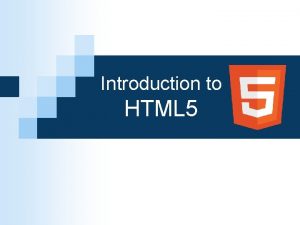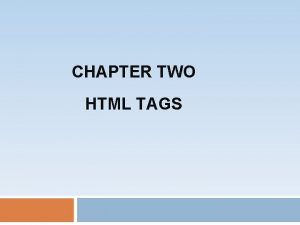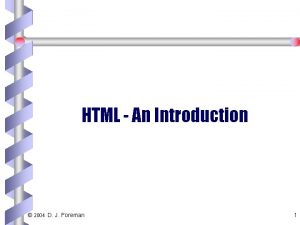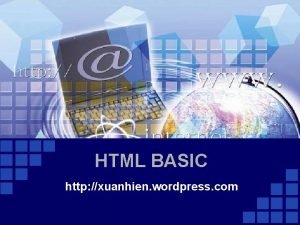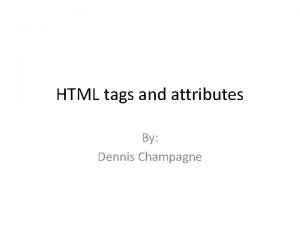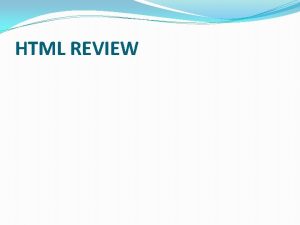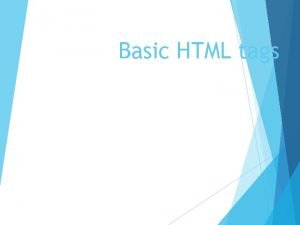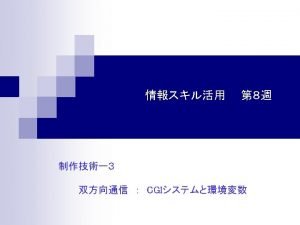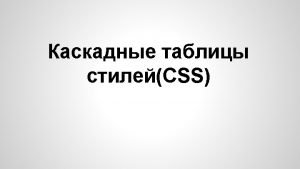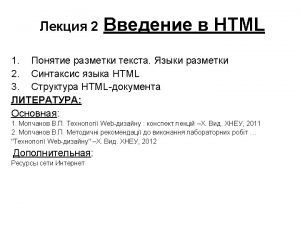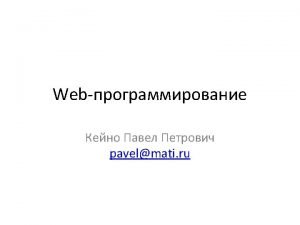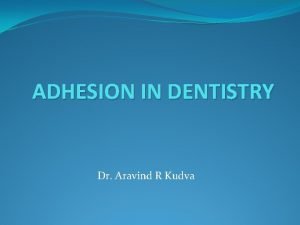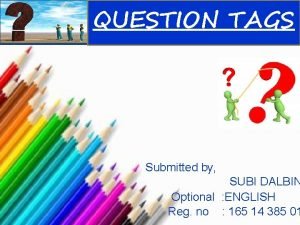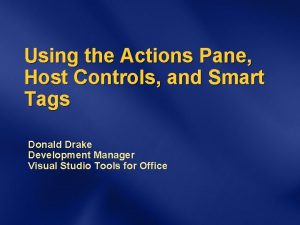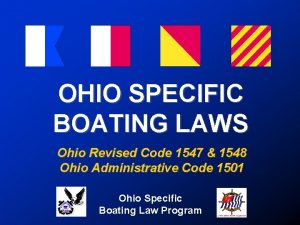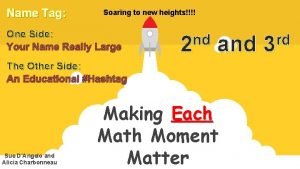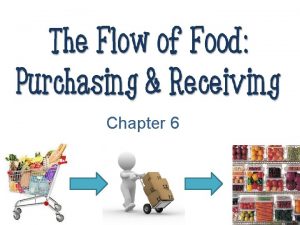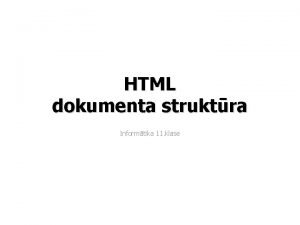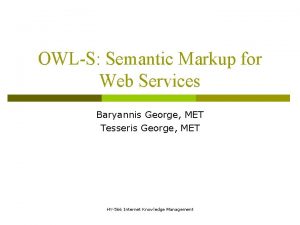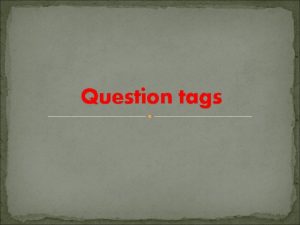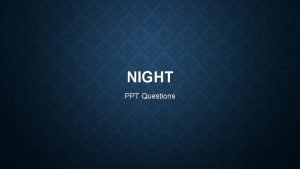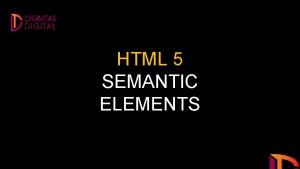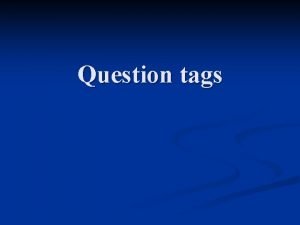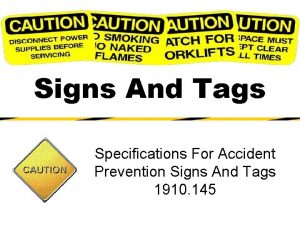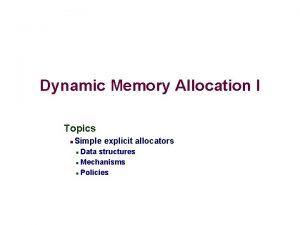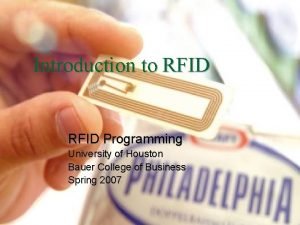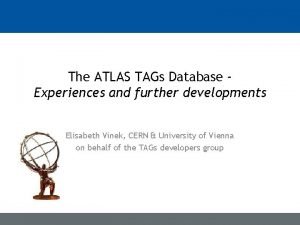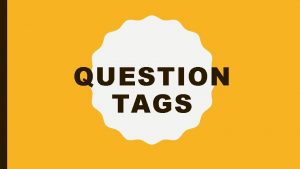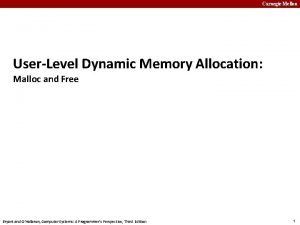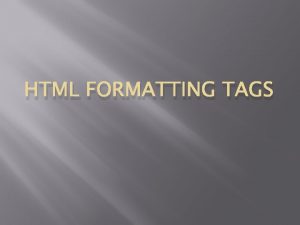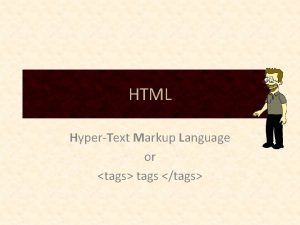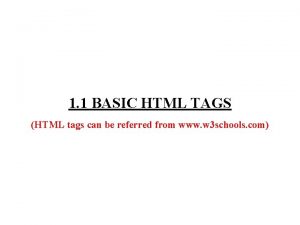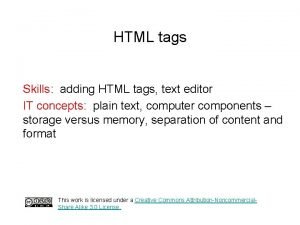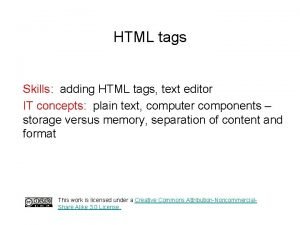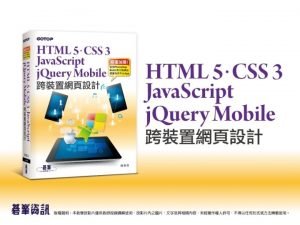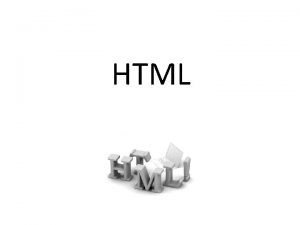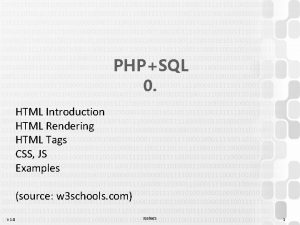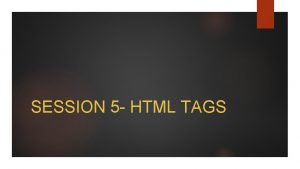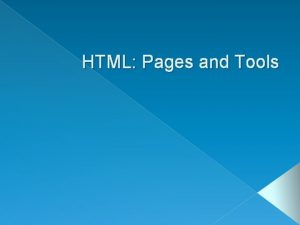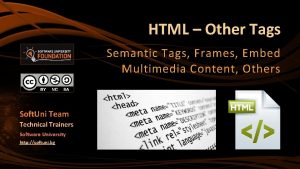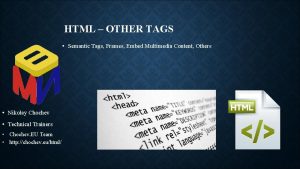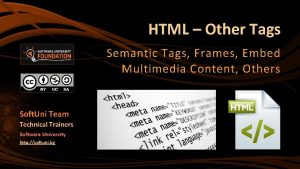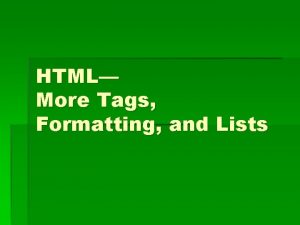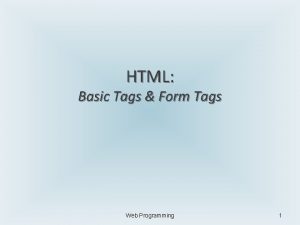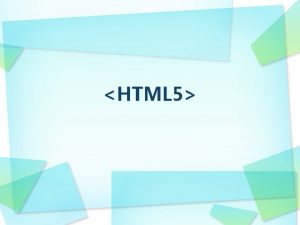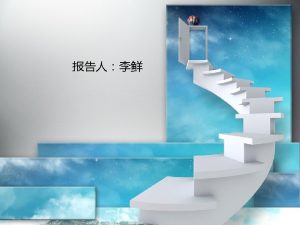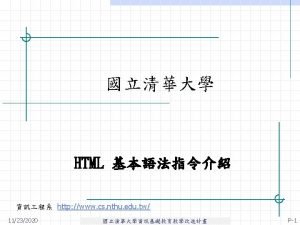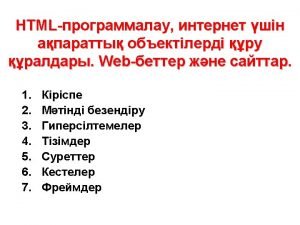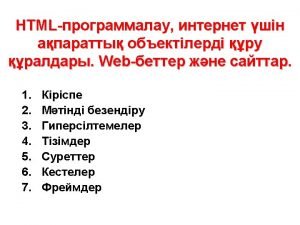Review of HTML Ch 1 Review of tags



































- Slides: 35

Review of HTML Ch. 1

Review of tags covered • <html> </html> • <body></body> • <title></title> • <p> </p> • <table></table> <table border =“ 1”> <th></th> <tr></tr> <td></td> <caption></caption> • <ol> • <li> • <ul> • <h 2> various header tags • Img tag • Style, attributes and values • alt

Digitizing Data • Chapter 7

Digitizing Discrete Information • The dictionary definition of digitize is to represent information with digits. • Digit means the ten Arabic numerals 0 through 9. • Digitizing uses whole numbers to stand for things.

The Pand. A Representation • Pand. A is the name used for two fundamental patterns of digital information: – Presence – Absence • Pand. A is the mnemonic for “Presence and Absence” • A key property of Pand. A is that the phenomenon is either present or not

A Binary System • The Pand. A encoding has two patterns: present and absent • Two patterns make it a binary system • There is no law that says on means “present” or off means “absent”

Bits Form Symbols • In the Pand. A representation, the unit is a specific place (in space and time), where the presence or absence of the phenomenon can be set and detected. • The Pand. A unit is known as a bit • Bit is a contraction for “binary digit” • Bit sequences can be interpreted as binary numbers • Groups of bits form symbols

Bits in Computer Memory • Memory is arranged inside a computer in a very long sequence of bits • Going back to the definition of bits (previous slide), this means that places where the physical phenomenon encoding the information can be set and detected

Hex Explained • Hex digits, short for hexadecimal digits, are base-16 numbers • A bit sequence might be given in 0’s and 1’s: – 111110011000101010 • Writing so many 0’s and 1’s is tedious and error prone • There needed to be a better way to write bit sequences…hexadecimal digits

The 16 Hex Digits • The digits of the hexadecimal numbering system are 0, 1, . . . , 9, A, B, C, D, E, F • Because there are 16 digits (hexits), they can be represented perfectly by the 16 symbols of 4 -bit sequences: – The bit sequence 0000 is hex 0 – Bit sequence 0001 is hex 1 – Bit sequence 1111, is hex F

Hex to Bits and Back Again • Because each hex digit corresponds to a 4 -bit sequence, easily translate between hex and binary – 0010 1011 1010 1101 2 B A D – F A B 4 1111 1010 1011 0100

Digitizing Numbers in Binary • The two earliest uses of Pand. A were to: – Encode numbers – Encode keyboard characters • Representations for sound, images, video, and other types of information are also important

Counting in Binary • Binary numbers are limited to two digits, 0 and 1 • Digital numbers are ten digits, 0 through 9 • The number of digits is the base of the numbering system Counting to ten

Counting in Binary • With decimal numbers, we use a place value representation where each “place” represents the next higher power of 10 • With binary numbers, it is the same idea, but with higher powers of 2

Place Value in a Decimal Number • Recall that To find the quantity expressed by a decimal number: – The digit in a place is multiplied by the place value and the results are added • Example, 1010 (base 10) is: – Digit in the 1’s place is multiplied by its place – Digit in the 10’s place is multiplied by its place – and so on: (0 × 1) + (1 × 10) + (0 × 100) + (1 × 1000)

Place Value in a Binary Number • Binary works the same way • The base is not 10 but 2 • Instead of the decimal place values: 1, 100, 1000, . . . , the binary place values are: 1, 2, 4, 8, 16, . . . ,

Place Value in a Binary Number • 1010 in binary: – (1 × 8) + (0 × 4) + (1 × 2) + (0 × 1)


Digitizing Text • The number of bits determines the number of symbols available for representing values: – n bits in sequence yield 2 n symbols • The more characters you want encoded, the more symbols you need

Digitizing Text • Roman letters, Arabic numerals, and about a dozen punctuation characters are about the minimum needed to digitize English text • What about: – Basic arithmetic symbols like +, −, *, /, =? – Characters not required for English ö, é, ñ, ø? – Punctuation? « » , ¿, π, ∀)? What about business symbols: ¢, £, ¥, ©, and ®? – And so on.

Assigning Symbols • We need to represent: – 26 uppercase, – 26 lowercase letters, – 10 numerals, – 20 punctuation characters, – 10 useful arithmetic characters, – 3 other characters (new line, tab, and backspace) – 95 symbols…enough for English

Assigning Symbols • To represent 95 distinct symbols, we need 7 bits – 6 bits gives only 26 = 64 symbols – 7 bits give 27 = 128 symbols • 128 symbols is ample for the 95 different characters needed for English characters • Some additional characters must also be represented

Assigning Symbols • ASCII stands for American Standard Code for Information Interchange • ASCII is a widely used 7 -bit (27) code • The advantages of a “standard” are many: – Computer parts built by different manufacturers can be connected – Programs can create data and store it so that other programs can process it later, and so forth

Extended ASCII: An 8 -Bit Code • 7 -bit ASCII is not enough, it cannot represent text from other languages • IBM decided to use the next larger set of symbols, the 8 -bit symbols (28) • Eight bits produce 28 = 256 symbols – The 7 -bit ASCII is the 8 -bit ASCII representation with the leftmost bit set to 0 – Handles many languages that derived from the Latin alphabet

NATO Broadcast Alphabet • The code for the letters used in radio communication is purposely inefficient • The code is distinctive when spoken amid noise • The alphabet encodes letters as words – Words are the symbols – “Mike” and “November” replace “em” and “en” • The longer encoding improves the chance that letters will be recognized • Digits keep their usual names, except nine, which is known as niner

NATO Broadcast Alphabet

Bar Codes • Universal Product Codes (UPC) also use more than the minimum number of bits to encode information • In the UPC-A encoding, 7 bits are used to encode the digits 0 – 9

Bar Codes • UPC encodes the manufacturer (left side) and the product (right side) • Different bit combinations are used for each side • One side is the complement of the other side • The bit patterns were chosen to appear as different as possible from each other

Bar Codes • Different encodings for each side make it possible to recognize whether the code is right side up or upside down

Why “Byte”? • Computer memory is subject to errors • An extra bit is added to the memory to help detect errors – A ninth bit per byte can detect errors using parity • Parity refers to whether a number is even or odd – Count the number of 1’s in the byte. If there is an even number of 1’s we set the ninth bit to 0

Why “Byte”? • All 9 -bit groups have even parity: – Any single bit error in a group causes its parity to become odd – This allows hardware to detect that an error has occurred – It cannot detect which bit is wrong, however

Why “Byte”? • IBM was building a supercomputer, called Stretch • They needed a word for a quantity of memory between a bit and a word” – A word of computer memory is typically the amount required to represent computer instructions (currently a word is 32 bits)

Why “Byte”? • Then, why not bite? • The ‘i’ to a ‘y’ was done so that someone couldn’t accidentally change ‘byte’ to ‘bit’ by the dropping the ‘e’ ” – bite – byte bit byt (the meaning changes) (what’s a byt? )

Summary • We began the chapter by learning that digitizing doesn’t require digits—any symbols will do • We explored the following: – Pand. A encoding, which is based on the presence and absence of a physical phenomenon. Their patterns are discrete; they form the basic unit of a bit. Their names (most often 1 and 0) can be any pair of opposite terms.

Summary • We explored the following: – 7 -bit ASCII, an early assignment of bit sequences (symbols) to keyboard characters. Extended or 8 bit ASCII is the standard. – The need to use more than the minimum number of bits to encode information. – The mystery of the y in byte.
 02.html?page=
02.html?page= History of html
History of html Example of html tag
Example of html tag Unpaired tags in html examples
Unpaired tags in html examples Xuanhien.wordpress
Xuanhien.wordpress Html tags list with examples
Html tags list with examples Mandatory html tags
Mandatory html tags Markup tag tells the web browser
Markup tag tells the web browser Structural tags example
Structural tags example Doctype html html head
Doctype html html head Canvas доска
Canvas доска 1
1 Slidetodoc.com
Slidetodoc.com Slidetodoc.com
Slidetodoc.com Ekahau rtls
Ekahau rtls Tcs foods
Tcs foods Microtags and macro tags
Microtags and macro tags It's very hot today question tag
It's very hot today question tag Actions pane 3
Actions pane 3 Expired tags orc
Expired tags orc Sewing name tags
Sewing name tags What must be done after receiving a key drop delivery?
What must be done after receiving a key drop delivery? What are the types of question tags?
What are the types of question tags? Tagi html
Tagi html Semantic tags
Semantic tags Question tags exceptions
Question tags exceptions Ppt on question tags
Ppt on question tags Non-semantic elements
Non-semantic elements Question tag in simple present tense
Question tag in simple present tense Passport accountability system
Passport accountability system Accident prevention signs
Accident prevention signs Explicit memory allocation
Explicit memory allocation Rifd readers houston
Rifd readers houston Atlas tags
Atlas tags Negative question tags examples
Negative question tags examples Malloc
Malloc

